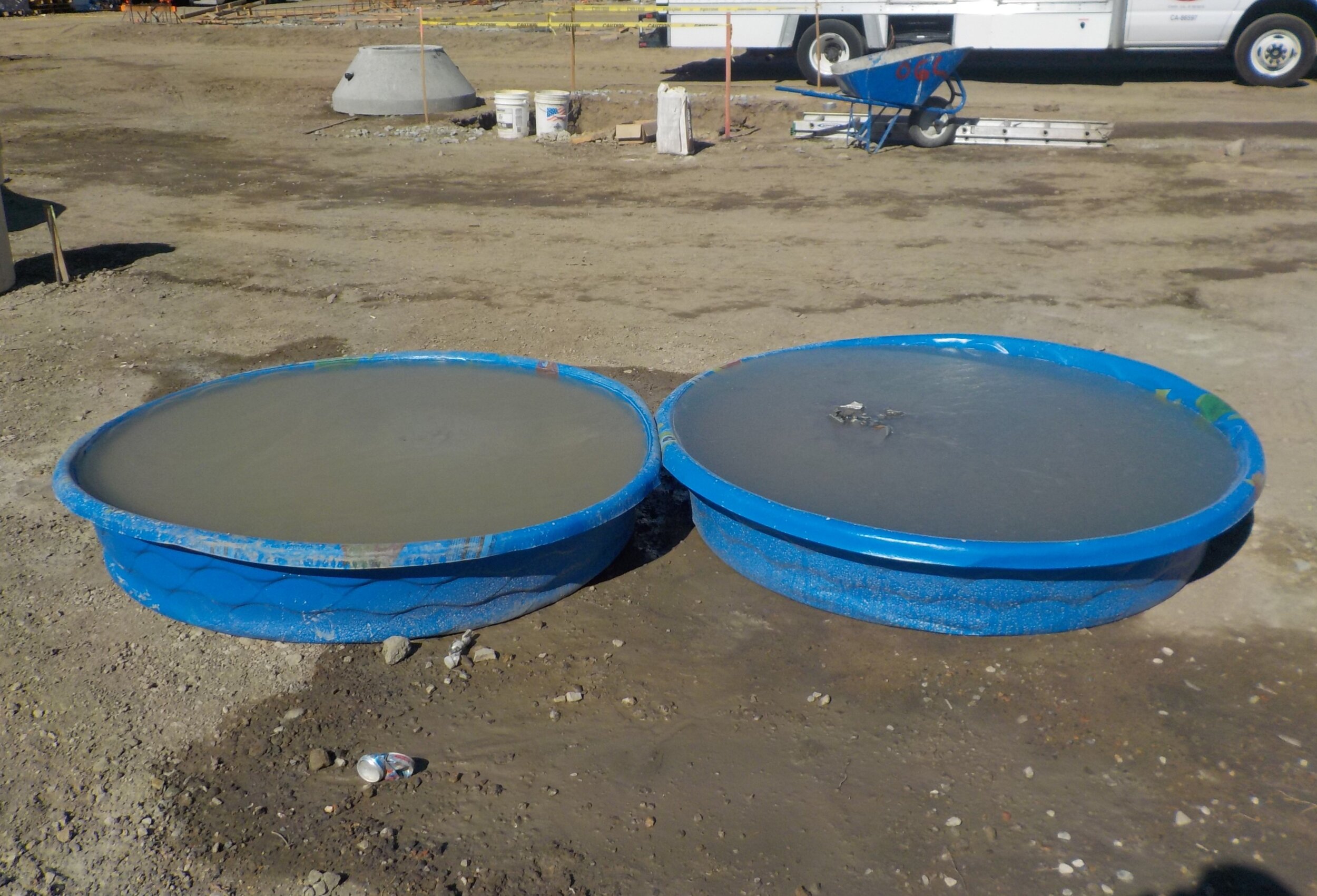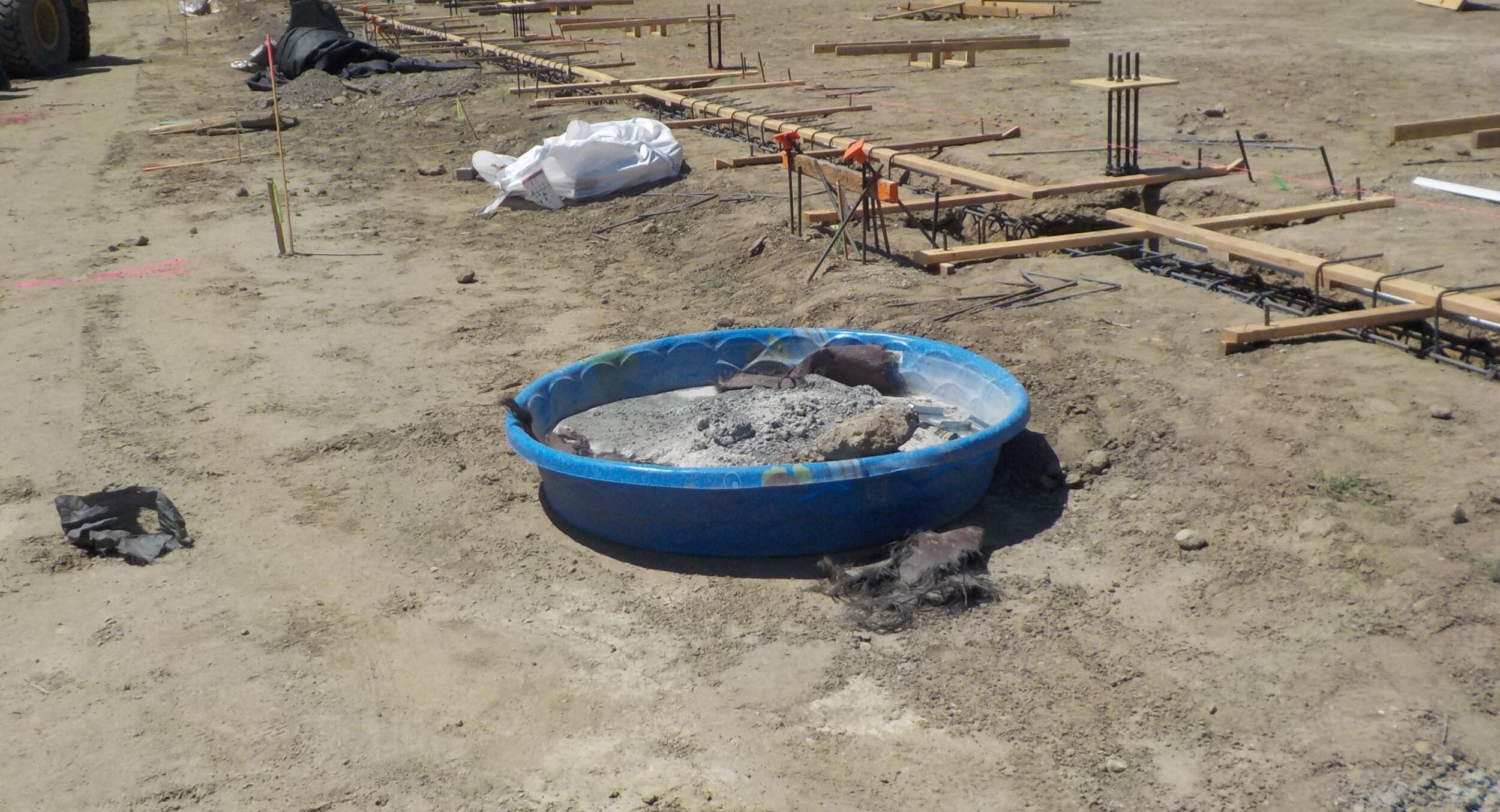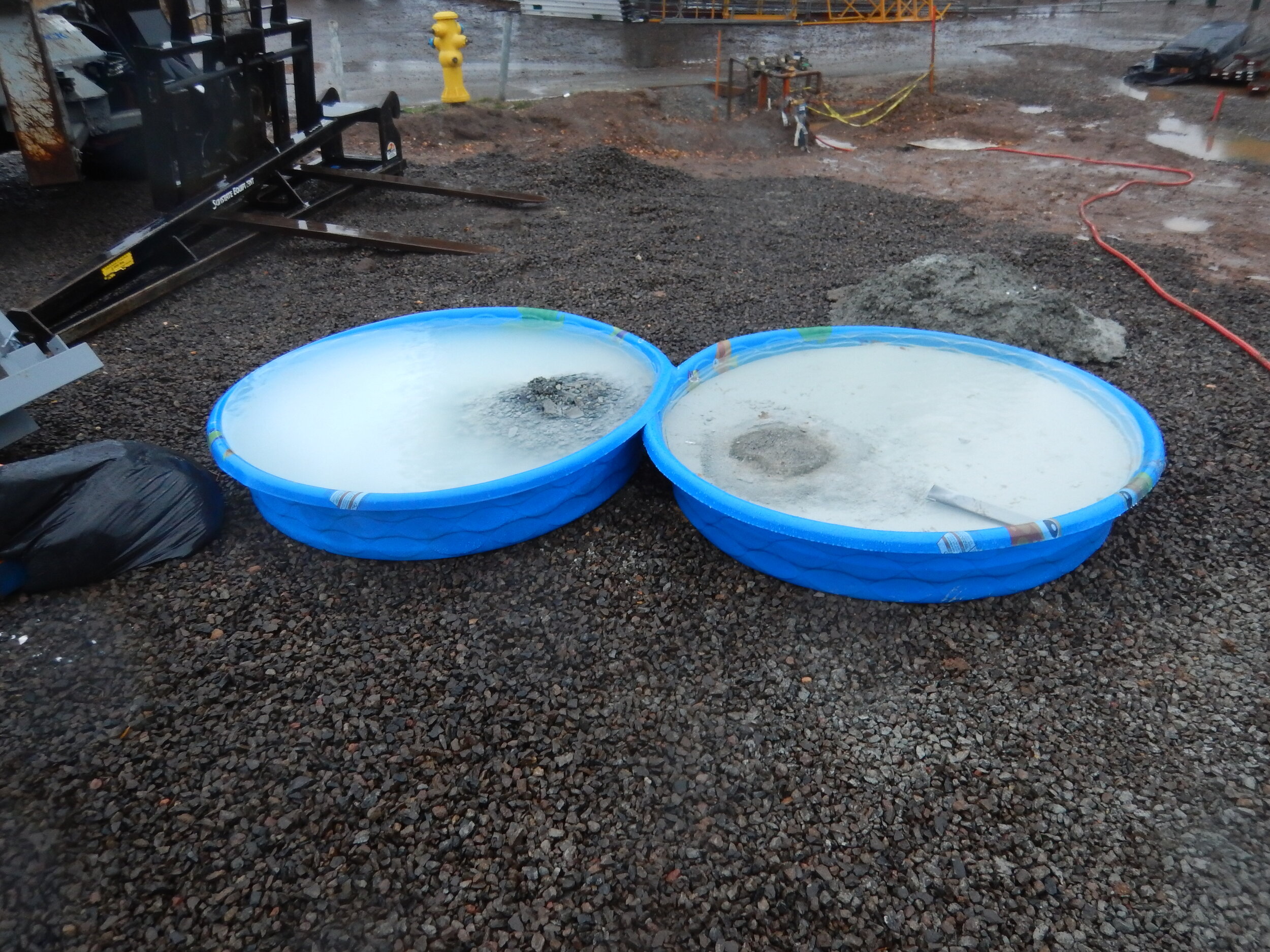The verdict is in... Kiddie Pools are for swimming, not for your washout
The little blue swimming pool is not all sunshine and rainbows. I totally get it, these kiddie pools are easy to find and cheap to buy. But unfortunately, they're just not enough for a concrete washout.
We work on a lot of Caltrans projects, and conversations about Caltrans-approved washouts keep coming up. Kiddie Pools are definitely a hot topic. They're convenient, but do have their limitations.




Why are concrete washouts needed?
Cement mixers need to be washed out to prevent cement from drying and damaging the mixing equipment. Sometimes these mixers will have their own reclaiming unit on them that retains most of the wastewater.
Cement is caustic and can cause severe burns, it's definitely not something we want entering our waterways. You'll need a way to properly contain washout to prevent this wastewater from entering nearby water bodies and stormwater conveyance systems.
You'll see quite a bit of language in the specs outlining the rules and regulations for proper disposal as well as details for how to install a washout per spec. Regulators want to make sure that washouts are built to be leak-proof, made of materials that are designed for contact with caustic cement slurry, and are large enough to meet your washout needs.
Commercially available washout's are some of the best options. We recommend plastic underneath for spill control.
Are Kiddie Pools approved?
Yes and no (mostly no). Per Caltrans Specs, Kiddie Pools are not approved because they're too small and not labeled, designed, or rated for exclusive use as a concrete washout. You can use them for spill control, pump truck priming, and secondary containment. If you're in a tight space, you can also use a Kiddie Pool for small washout needs. A larger washout built to spec must be located on the site to transfer the waste to a more compatible unit.
For projects that are not following Caltrans spec, it's probably okay to use. You should always check your Contract Documents to confirm. As a rule of thumb, we generally recommend sticking with Caltrans specifications since they're more comprehensive.
What's the "best practice" washout I should be using?
In general, the best washouts are the commercially available roll-off type with tracks that allow the cement truck to back in and wash out. They're more expensive, and may not be available in remote locations. These commercial washouts are a really great option if you can get one.
While they are our preferred option, there's still room for error. The rubber in the gasket may become dry and brittle, and could leak over time if there's enough deterioration. If you see any leaks, have the washout replaced by the provider. We also recommend placing the washout on plastic to provide drip and spill protection while your crew uses the facility.
Where can I dispose of Concrete washout waters?
At an approved facility. The Yolo Landfill has an approved facility if you're in the Sacramento area. They dry the washout and recycle the water. The dried concrete waste will be landfilled or broken into rubble or reused.
Are the orange bagged washouts acceptable?
They are approved if they hold at least 55 gallons. We still recommend a larger washout, but this is good for smaller areas.
The orange-bagged washouts are great for small spaces.
How do you know if a washout is acceptable?
Check your Contract Documents that were available at the time of Bid. These are the requirements that you are subject to follow. There should be a section dedicated to Concrete Washouts.
What are some general tips for properly managing washouts on-site?
Building a washout per spec the first time will prevent a lot of maintenance down the road. The convenience and savings from preventing a non-stormwater discharge are worth it. Her are a couple of other tips to get you started...
Select a flat and level location for your washout that's 50 feet away from a drainage course or storm drain (possibly farther if listed in your permits/specs).
Maintain adequate freeboard, i.e. don't fill to more than 6" from the upper rim. If they become full, have them serviced, and properly dispose of the waste at an approved facility.
Washouts need to be covered when inactive, especially prior to a rain event.
Caltrans Washout Specifications
The following is listed in the 2018 Caltrans Standard Specifications. Section 13-9 includes specifications for installing temporary concrete washouts.
You may use any of the following systems for a temporary concrete washout:
Temporary concrete washout facility
Portable temporary concrete washout
Temporary concrete washout bin
At least 5 business days before starting concrete activities, submit an informational submittal that includes:
Location of each concrete washout
Name and location of the off-site disposal site to receive the concrete waste
Copy of the permit issued by the RWQCB for the off-site commercial disposal site
Copy of the permit issued by the state or local agency with jurisdiction over a disposal site located outside of the State
Retain and submit tracking records for the disposal of concrete waste as an informational submittal. Submit a certificate of compliance for (1) the fabric bag for gravel-filled bags and (2) the plastic liner.
The sign for a concrete washout must comply with section 12-3.11B(3) except the sign panel may be plywood. The sign panel must be at least 4 by 2 feet. The sign legend must read Concrete Washout in at least 6-inch-high black letters on a white background.
13-9.02B Temporary Concrete Washout Facilities
Stakes for a temporary concrete washout facility must comply with section 13-10.02C.
Straw bales for a temporary concrete washout facility must comply with section 13-10.02H.
Gravel-filled bags for a temporary concrete washout facility must comply with section 13-5.02G.
The plastic liner for a temporary concrete washout facility must be:
New single-ply polyethylene sheeting without seams or overlapping joints
At least 10 mils thick
Free of holes, punctures, tears, or other defects
13-9.02C Portable Temporary Concrete Washouts
A portable temporary concrete washout must be a commercially available, watertight container with enough capacity to contain all liquid and concrete waste generated by washout activities without seepage or spills and be:
At least 55 gallons in capacity.
Labeled for exclusive use as a concrete waste and washout facility. Concrete Washout must be stenciled in 3-inch-high black letters on a white background with the top of the letters placed 12 inches from the top of the container.
13-9.02D Temporary Concrete Washout Bins
A temporary concrete washout bin must be a commercially available, watertight container with enough capacity to contain all liquid and concrete waste generated by washout activities without seepage or spills and be:
At least 5 cubic yards in capacity
Roll-off type with or without folding steel ramps
Labeled for exclusive use as a concrete waste and washout facility
13-9.03 CONSTRUCTION
Place a concrete washout at the job site:
Before starting concrete placement activities
In the immediate area of concrete work where authorized
No closer than 50 feet from any storm drain inlet, open drainage facility, ESA, or watercourse
Away from traffic or public access areas
Install a concrete washout sign adjacent to each concrete washout location.
Use a concrete washout to collect:
Washout from concrete delivery trucks
Slurries containing concrete or asphalt from saw cutting, coring, grinding, grooving, and hydrodemolition
Concrete waste from mortar mixing stations
Do not fill a concrete washout higher than 6 inches below the upper rim.
Dispose of concrete waste within 2 business days after a concrete washout becomes full. Dispose of concrete waste from a concrete washout at a plant licensed to receive solid concrete waste, liquid concrete waste, or both. Relocate a portable temporary concrete washout or bin as needed for concrete work. The Department does not pay for relocating a portable temporary concrete washout or bin. Secure a portable temporary concrete washout or bin to prevent spilling concrete waste when relocating or transporting it within the job site. If you spill concrete waste, clean up the spilled material and place it back into the concrete washout unit.
We've seen it all. The good, bad, and ugly. Our role as Stormwater Inspectors is to help educate our clients on best practices, be proactive with our recommendations and guidance, and work collaboratively with our clients when sh** hits the fan.
In our 15 years of experience in the industry, we've learned that effective compliance doesn't come from passive-aggressive corrective actions reports, but cooperative teamwork and problem-solving. Our Inspectors are approachable, knowledgeable, and friendly.
We take training very seriously. New Inspectors receive over 40 hours of training at the start of employment and participate in consistent weekly education throughout their careers. From there, our Team works to obtain certifications and complete the necessary training, including QSP, CISEC, 8-Hour Caltrans WPCM, and Title 22 Hazardous Waste Generator Training.
Contact our Estimating Team at (707) 693-1926 or email estimating@tullygroup.com for a proposal.
If you want more blogs and tips, be sure to subscribe to our emailing list https://www.tullygroup.com/sign-up
For behind-the-scenes and project highlights, check out our social media
Thanks for reading! Don't forget to share with your co-workers! That helps a ton.
Have any questions for us to answer? Comment them down below!
Author: Kaeli Tully, QSP
Peer Review: Mae Shulman
Lesson Prepared By: Robin Tully, QSD, PE, ToR





